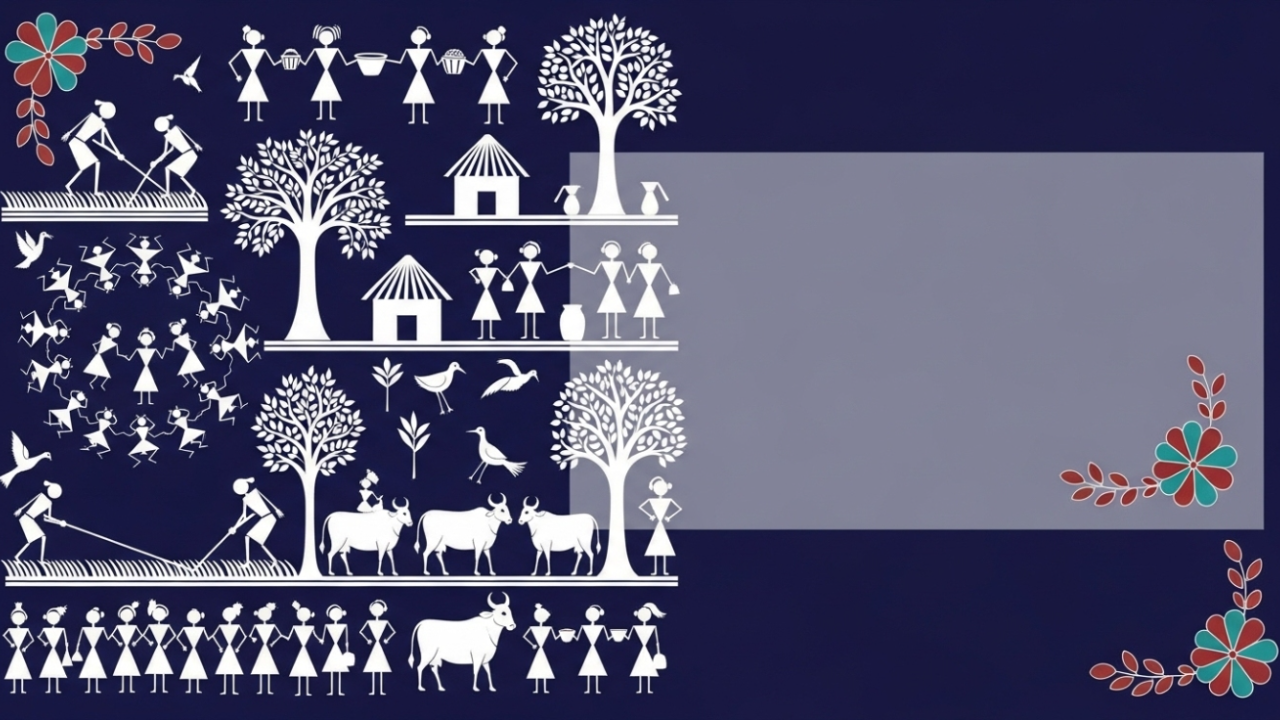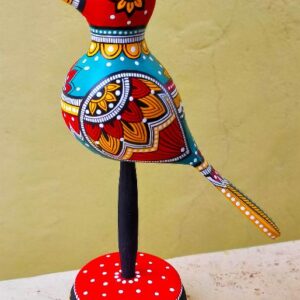Madhubani Painting History: Origin, Evolution, and Cultural Significance

About the Author
Mohd Amaan
Mohd Amaan is an Artist, Writer & Creative Expert at Artisthu. He blends fine art with modern design and storytelling, helping creators present their work beautifully and effectively online.
Table of Contents
ToggleMadhubani Painting History: Origin, Evolution, and Cultural Significance
Madhubani painting, often referred to as Mithila art, is among the oldest and most culturally vibrant traditional art forms of India. Its origin lies in the Mithila region of Bihar, where it developed as a form of ritualistic wall painting and later evolved into one of the most celebrated folk arts in the world. The history of Madhubani art is deeply rooted in traditions, mythology, and cultural practices, making it an essential part of Indian heritage.
Known for its intricate patterns, symbolic motifs, and vibrant use of colors, Madhubani painting is more than just an art form—it is a visual expression of cultural identity, spirituality, and community values. From marriage rituals to festivals and mythological stories, every Madhubani painting carries meaning and heritage.
The Origin of Madhubani Painting
The origin of Madhubani painting is often traced back to the ancient Indian epic Ramayana. According to popular legend, King Janaka of Mithila commissioned artists to decorate the walls of his kingdom during the marriage of his daughter Sita to Lord Rama. From that time, the practice of decorating walls and floors with symbolic paintings during festivals and important events became a tradition in Mithila.
Historically, these paintings were created by women on the walls of their mud houses, using natural colors derived from plants, minerals, and other organic sources. Over centuries, the art form was passed down from one generation to another, preserving its authenticity and traditional values. This explains why the Madhubani painting’s origin and history are strongly connected with the cultural and spiritual life of the Mithila region.
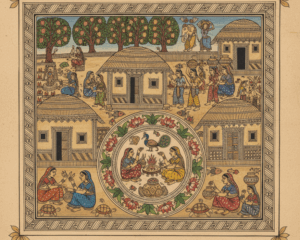
Madhubani Painting: Which State Is Famous for It?
When discussing the roots of Madhubani painting, a common question arises: Madhubani painting is famous in which state? The answer lies in Bihar, specifically in the Mithila region of northern Bihar and parts of Nepal. Bihar folk art is widely recognized for its authenticity and cultural depth, and Madhubani is undoubtedly its most famous representation.
While many Indian folk paintings exist, Madhubani painting heritage stands out because of its unique style, detailed symbolism, and connection to daily rituals and Hindu mythology. Today, this art is not just confined to Bihar but is celebrated worldwide, with international exhibitions, art fairs, and academic research emphasizing its significance in Indian folk art history.
Evolution of Madhubani Painting
The evolution of Madhubani painting reflects the resilience of traditional art in adapting to changing times. Initially, the art was restricted to walls, floors, and courtyards of homes, created with natural pigments and simple tools like twigs, matchsticks, and fingers. The themes revolved around marriage rituals, fertility, harvest, and religious stories.
However, during the 1960s, a severe drought in Bihar led to economic hardship in the region. To provide livelihood support, local women were encouraged to recreate their wall paintings on handmade paper for sale. This marked a turning point in the history of Madhubani art, as it began transitioning from domestic ritual paintings to commercial artworks. Soon, Madhubani gained global recognition as a unique and vibrant form of Indian folk painting.

Traditional Styles of Madhubani Art
Madhubani painting does not follow a single style; instead, it encompasses a variety of techniques and artistic expressions. Over time, it developed into five major styles—Katchni, Bharni, Tantrik, Kohbar, and Godna. Each of these styles represents a different aspect of life, spirituality, and symbolism.
The Katchni style is recognized for its fine lines and patterns, the Bharni style emphasizes bright colors and filled spaces, the Tantrik style depicts religious and spiritual subjects, the Kohbar style focuses on marriage rituals and fertility themes, and the Godna style is inspired by tattoo patterns. These traditional Madhubani art forms demonstrate the depth and diversity of Mithila painting history.
Symbolism in Madhubani Painting
Madhubani painting is not just an aesthetic practice; it carries deep symbolic meanings. Every motif, pattern, and color used in these paintings has cultural and spiritual significance. For example, the fish represents fertility and prosperity, the peacock stands for beauty and love, and the lotus symbolizes purity and divinity.
In Madhubani art, the sun and moon frequently appear as motifs, representing the passage of time, continuity, and the eternal cycle of life. Similarly, the depiction of Hindu gods and goddesses such as Krishna, Rama, Shiva, Durga, and Lakshmi highlights the religious foundation of the art. This strong influence of Hindu mythology in Madhubani paintings makes it an integral part of spiritual and cultural practices.
Cultural Heritage of Bihar Through Madhubani
The cultural heritage of Bihar is incomplete without Madhubani paintings. Being among the earliest forms of Indian folk art, it reflects the cultural traditions of the Mithila region and portrays its lifestyle and values. From celebrating harvests to decorating homes during festivals like Holi, Diwali, and weddings, Madhubani paintings have always played an essential role in community identity.
This art form also emphasizes the pivotal role of women, who were its earliest creators and guardians. In many ways, Madhubani art has become a voice of the Mithila women, expressing their spirituality, emotions, and social realities. The continued practice of Madhubani paintings shows the strength of cultural traditions in Bihar.
Social and Ritual Importance of Madhubani Art
Madhubani paintings have never been just decorative; they have always played a central role in social and religious rituals of Mithila. Traditionally, these paintings were considered auspicious during marriages, childbirth, and festivals. The Kohbar Ghar, or nuptial chamber, was adorned with Madhubani paintings symbolizing fertility, prosperity, and divine blessings for the couple. Even today, in many villages of Bihar, families create ritualistic Madhubani motifs on their walls to mark special occasions. This shows how deeply intertwined the art is with everyday life and spiritual customs.
An equally intriguing feature of Madhubani paintings is their role in strengthening community ties. Women from different households often came together to create large murals, turning the act of painting into a collective celebration. This tradition helped preserve not only the art but also the values of togetherness and cultural pride among the people of Mithila.
Natural Colors and Artistic Techniques
One of the most unique features of Madhubani painting is the use of natural colors. Originally, artists prepared colors from plants, flowers, and household items. For instance, turmeric was used for yellow, indigo for blue, neem leaves for green, and rice paste for white. The black outline, which is a signature element of the art, was made using soot mixed with cow dung or natural resin. These handmade colors not only ensured eco-friendliness but also gave the paintings their distinctive earthy charm.
The tools were equally simple—twigs, bamboo sticks, cotton, and even fingers were used to apply the colors with precision. Despite this simplicity, the level of detail in Madhubani paintings remains astonishing. Fine lines, geometric borders, and repeating patterns create a mesmerizing rhythm, showcasing the mastery of traditional artists. The reliance on natural resources also reflects the deep ecological wisdom of the Mithila people, who maintained harmony between art and nature.
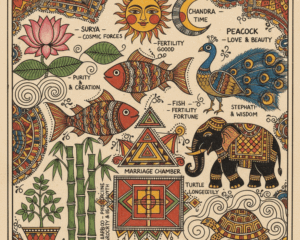
Global Appeal and Modern Adaptations
In recent years, Madhubani art has gone beyond traditional paper and canvas to find expression in modern mediums. Designers and fashion brands now incorporate Madhubani motifs into sarees, kurtas, handbags, and even footwear. Home décor products like cushion covers, lamps, and wall hangings adorned with Madhubani patterns are gaining popularity among urban buyers. This fusion of traditional designs with contemporary products has brought the art closer to global markets.
International recognition has also played a vital role in its revival. Exhibitions in countries like Japan, the USA, and France have showcased the intricate beauty of Madhubani paintings, making them a subject of fascination among art lovers worldwide. With the rise of e-commerce and social media, many young artists from Bihar are now directly connecting with buyers across the globe, ensuring that this age-old tradition continues to thrive in the digital era.
Women Empowerment Through Madhubani
Perhaps the most remarkable impact of Madhubani art is on women’s empowerment. Historically, the art was predominantly practiced by women, who expressed their creativity and spirituality through these paintings. What began as a household activity has now turned into a major source of income and recognition for women artists in Bihar.
Government initiatives and NGOs have trained thousands of women to commercialize their art, leading to financial independence and social upliftment. Renowned artists like Sita Devi, Ganga Devi, and Baua Devi not only gained national awards but also took Madhubani painting to international stages. Their success stories have inspired many younger women to preserve and promote this cultural legacy. In many ways, Madhubani has become a medium of both cultural preservation and women-led economic empowerment.
Madhubani Art in Indian History and Global Recognition
The place of Madhubani art in Indian history is significant. It is one of the few art forms that have retained their original identity while also gaining worldwide recognition. International museums, art galleries, and cultural festivals have showcased Madhubani art, bringing it into the global spotlight.
In 2007, Madhubani painting received the Geographical Indication (GI) tag, giving it protection and authenticity as an exclusive cultural product of Bihar. This recognition further strengthened its identity in folk art history in India. Beyond exhibitions, Madhubani art is now used in textiles, home décor, and fashion, making it a living tradition that continues to evolve.
Preservation and Future of Madhubani Painting
In recent decades, several steps have been taken to preserve the authenticity and future of Madhubani paintings. Artists continue to use natural dyes and traditional methods, although synthetic colors and modern mediums are also common. NGOs, government bodies, and international organizations have promoted Madhubani painting through training programs, exhibitions, and online marketplaces.
This process has provided a stable source of livelihood for thousands of artists in Bihar. At the same time, digital platforms have opened new possibilities for spreading awareness about Madhubani painting history and tradition to younger generations worldwide. Preserving this art ensures that one of the most remarkable examples of Indian folk paintings continues to inspire artists and audiences across cultures.
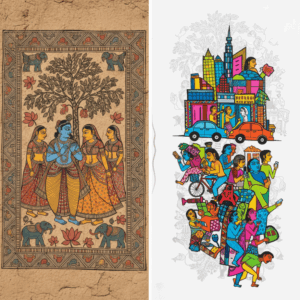
FAQs About Madhubani Painting History
Q1: Madhubani painting is famous in which state?
Madhubani painting is famous in Bihar, particularly in the Mithila region.
Q2: What is the origin of Madhubani painting?
It originated during the time of King Janaka of Mithila, with its earliest examples found in wall paintings created during the marriage of Sita and Rama in the Ramayana.
Q3: What are the themes of Madhubani paintings?
The themes include Hindu mythology, fertility, love, nature, festivals, and prosperity.
Q4: What makes Madhubani art unique?
Its unique use of vibrant colors, detailed line work, and strong symbolic meanings rooted in cultural and spiritual traditions make it distinct.
Q5: How has Madhubani painting evolved over time?
It evolved from wall paintings to paper and canvas art, gaining global recognition and commercial success while maintaining its traditional roots.
Conclusion
The history of Madhubani painting is a story of tradition, resilience, and cultural identity. From its ancient origin in the Mithila region of Bihar to its recognition as a global folk art, Madhubani painting represents the spirit of Indian cultural heritage. Its symbolism, rooted in Hindu mythology and nature, continues to inspire both traditional artists and modern creators.
As one of the oldest living art forms, Madhubani painting is not just a reflection of Bihar folk art but a testimony to the richness of Indian folk paintings. Supporting Madhubani artists and appreciating their work is a way of keeping this art alive for future generations.

Written by: Mohd Amaan

